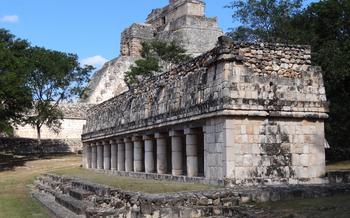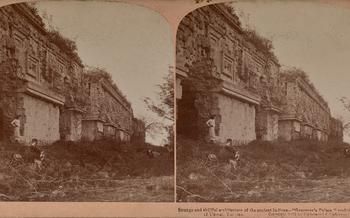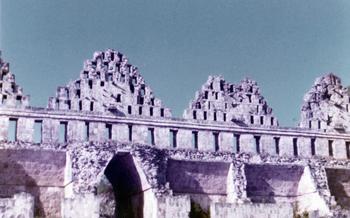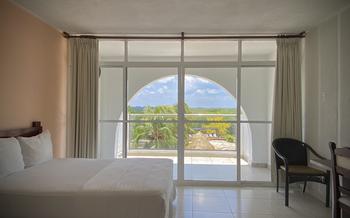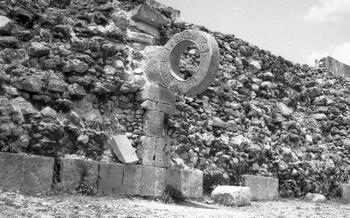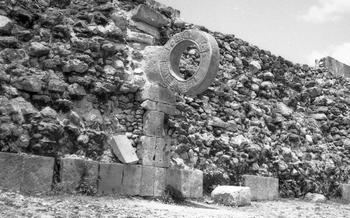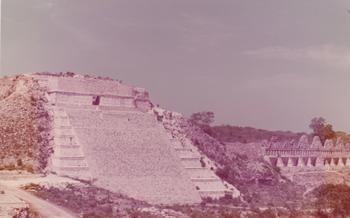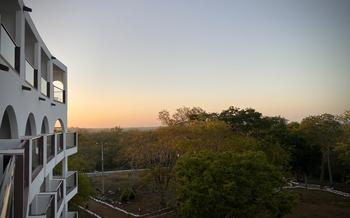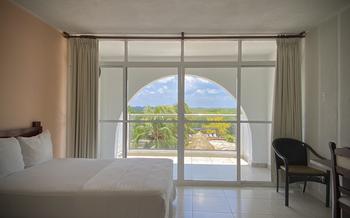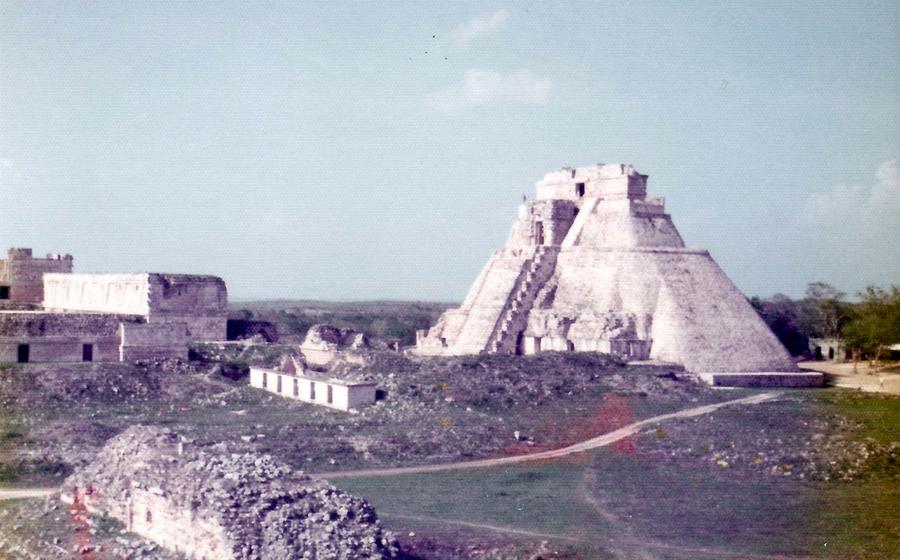
South Temple
- Unveiling Uxmal's Grandeur
- The South Temple's Allure
- Exploring the Temple's Exterior
- Stepping into the Temple's Interior
- The Temple's Reconstruction and Conservation
- The Temple's Place in Mayan Cosmology
- Excavations and Archaeological Discoveries
- The Temple's Role in Modern-Day Celebrations
- Tips for Visiting the South Temple:
- The South Temple's Enigmatic Past
- The Temple's Impact on Modern Architecture
- The Temple's Connection to Other Mayan Sites
- The Temple's Importance for Sustainable Tourism
- Local Legends and Myths Surrounding the Temple
- Insider Tip: Unveiling the Temple's Secrets
Unveiling Uxmal's Grandeur
Uxmal, a city steeped in Mayan history and cultural significance, stands as a testament to the ingenuity and architectural prowess of the ancient Maya. Located in the Puuc region of Mexico's Yucatán Peninsula, Uxmal ranks among the most impressive and well-preserved Mayan sites, boasting a remarkable collection of temples, palaces, and pyramids. Its name, derived from the Mayan language, translates to "three times built," a reference to the city's resilience and its ability to rise from the ashes of past conflicts.
Uxmal's architectural marvels set it apart from other Mayan cities. Its buildings showcase the Puuc style, characterized by intricate stone carvings, decorative friezes, and corbelled arches. The city's iconic Pyramid of the Magician, with its elliptical base and towering height, is a marvel of engineering and a testament to the Maya's astronomical knowledge. The Nunnery Quadrangle, with its elaborate facades and well-preserved chambers, offers a glimpse into the lives of Uxmal's religious elite.
Uxmal's significance extends beyond its architectural wonders. It was a thriving metropolis, a center of political and economic power, and a hub for trade and cultural exchange. The city's strategic location, at the crossroads of important trade routes, contributed to its wealth and influence. Uxmal's legacy continues to captivate visitors with its grandeur, beauty, and the enduring spirit of the ancient Maya.
The South Temple's Allure
Amidst the architectural wonders of Uxmal, the South Temple stands as a testament to Mayan ingenuity and devotion. Its commanding presence within the complex draws visitors to explore its intricate details and unravel its symbolic significance. The temple's architectural style exemplifies the Puuc tradition, characterized by its corbelled arches, mask panels, and elaborate friezes. These decorative elements adorn the temple's façade, creating a visual symphony that captivates the eye.
The South Temple's design is not merely aesthetic; it holds profound symbolic and functional meanings. The temple's orientation aligns with the cardinal directions, reflecting the Mayan's understanding of astronomy and their connection to the cosmos. The temple's chambers served as sacred spaces for religious rituals and ceremonies, where Mayan priests performed offerings and invoked the divine.
Compared to other notable structures within Uxmal, the South Temple stands out for its impressive size and elaborate ornamentation. It rivals the Governor's Palace and the Nunnery Quadrangle in terms of architectural grandeur, showcasing the Maya's exceptional craftsmanship and their dedication to religious practices.
Exploring the Temple's Exterior
The South Temple's façade is a testament to the intricate artistry and symbolism that characterized Mayan architecture. Its towering walls are adorned with elaborate carvings depicting a rich array of deities, mythical creatures, and geometric patterns. These carvings served as a visual narrative, communicating stories and beliefs to the ancient Maya. The temple's exterior walls also feature hieroglyphic inscriptions, providing valuable insights into Mayan history and culture. These inscriptions often recorded important events, such as the accession of a new ruler or the completion of a significant construction project.
The temple's orientation is another fascinating aspect of its design. The South Temple is aligned with the cardinal directions, suggesting its importance in astronomical observations and calendrical rituals. The alignment allowed the Maya to track the movement of celestial bodies, such as the sun and the moon, and to determine the timing of important events, such as solstices and equinoxes. This alignment also reflects the Maya's belief in the interconnectedness of the earthly and celestial realms. The South Temple, with its imposing façade, intricate carvings, and celestial alignment, stands as a magnificent representation of Mayan architectural prowess and their deep connection to the cosmos.
Stepping into the Temple's Interior
As you cross the threshold of the South Temple, a palpable sense of awe and reverence engulfs you. The temple's interior is a sanctuary of shadows and echoes, a sacred space where ancient rituals and ceremonies once unfolded. The walls are adorned with intricate carvings and bas-reliefs that depict Mayan deities, mythical creatures, and scenes from everyday life. Each carving is a testament to the artistic prowess and religious devotion of the ancient Maya.
In the center of the temple, a stone altar stands as a silent witness to countless offerings and prayers. It is flanked by two massive stelae, each carved with hieroglyphic inscriptions that offer glimpses into the temple's history and significance. These stelae are like stone books, their glyphs revealing tales of ancient rulers, divine prophecies, and celestial events.
As you explore the temple's chambers, you can't help but feel a connection to the Maya who once worshipped here. The air seems charged with their presence, their voices echoing through the centuries. In your mind's eye, you can see the priests performing sacred rituals, the smoke of incense rising towards the heavens, and the faithful prostrating themselves before the altar, seeking blessings and guidance from the gods.
The South Temple's interior is not merely a physical space; it is a gateway to the past, a place where you can commune with the ancient Maya and experience the profound spirituality that permeated their lives.
The Temple's Reconstruction and Conservation
The South Temple, like many other ancient Mayan structures, has undergone extensive restoration and conservation efforts to preserve its grandeur for future generations. Archaeologists, conservators, and local communities have collaborated to restore the temple's crumbling facades, repair damaged carvings, and stabilize its overall structure.
One of the primary challenges in preserving the South Temple is maintaining its authenticity while incorporating modern conservation techniques. Conservators carefully analyze the original materials and construction methods to ensure that repairs are sympathetic to the temple's historical integrity. They employ specialized techniques to clean and consolidate the stone surfaces, preserving the intricate carvings and inscriptions.
The conservation process often involves removing vegetation and controlling moisture levels to prevent further deterioration. Archaeologists and conservators work together to document the temple's condition, monitor its structural stability, and identify areas that require immediate attention.
The importance of preserving Uxmal's cultural heritage cannot be overstated. The South Temple, as a significant part of this heritage, serves as a testament to the ingenuity and artistry of the ancient Maya. Conservation efforts not only protect the physical structure but also safeguard the stories and traditions that are embedded within its walls.
The Temple's Place in Mayan Cosmology
The South Temple held a significant place in the religious beliefs and practices of the ancient Maya. It served as a sacred space for astronomical observations and calendrical rituals. The temple's alignment with celestial bodies, such as the sun and the moon, allowed the Maya to track the passage of time and predict astronomical events. This knowledge was crucial for agricultural practices, religious ceremonies, and the overall understanding of the cosmos.
The temple's design and iconography also reflect the Maya's profound connection to the cosmos. The intricate carvings on the temple's façade depict various celestial bodies, including the sun, moon, and stars. These carvings symbolize the Maya's belief in the interconnectedness of the earthly and heavenly realms. The temple's orientation towards the cardinal directions further reinforces its role as a cosmic observatory.
Through the South Temple, the Maya sought to understand the patterns and cycles of the universe and their place within it. The temple served as a physical representation of the Maya's sophisticated cosmological beliefs, connecting them to the divine and the mysteries of the cosmos.
Excavations and Archaeological Discoveries
Extensive archaeological investigations have been conducted at the South Temple, shedding light on the rich history and culture of Uxmal. Excavations have unearthed a treasure trove of artifacts, including pottery, tools, jewelry, and ceremonial objects. These discoveries have provided valuable insights into the daily life, economy, and social organization of the ancient Maya.
The excavation of the temple's interior chambers has revealed altars, stelae, and other artifacts that were used in religious rituals and ceremonies. These findings have helped archaeologists understand the temple's function and its role in the spiritual life of the Maya.
The exploration of the temple's surroundings has also yielded significant discoveries. Archaeologists have uncovered evidence of residential areas, workshops, and other structures, indicating that the temple was part of a larger urban complex. These findings have contributed to a better understanding of the urban planning and social organization of Uxmal.
The ongoing archaeological research at the South Temple continues to uncover new insights into the ancient Maya civilization. These discoveries are helping to piece together the puzzle of Maya history and culture, revealing the complexity and sophistication of this remarkable civilization.
The Temple's Role in Modern-Day Celebrations
Despite the passage of time, the South Temple continues to hold a profound significance in the lives of contemporary Mayans. It serves as a sacred site where ancient traditions are revived, and cultural preservation efforts are undertaken. During significant Mayan festivals and celebrations, the temple becomes a focal point for rituals and ceremonies that honor the ancestors and celebrate Mayan identity. Local communities gather within the temple's hallowed halls, adorned in traditional attire, to participate in prayers, offerings, and dances that have been passed down through generations. The temple's enduring presence as a place of worship and spiritual connection underscores the deep reverence and respect that modern-day Mayans hold for their cultural heritage.
Tips for Visiting the South Temple:
Plan Your Visit: - The best time to visit Uxmal is during the dry season, from November to April, to avoid the intense heat and humidity of the summer months. - Guided tours are available to enhance your experience and provide insights into the temple's history and significance. - Consider visiting Uxmal as part of a guided tour that includes other nearby Mayan sites, such as Chichén Itzá and Ek Balam.
Amenities and Facilities: - The archaeological site offers basic facilities for tourists, including restrooms, a museum, and souvenir shops. - Refreshments and snacks are available at the site's small café, but it's recommended to bring your own water and snacks to stay hydrated. - There are designated parking areas for visitors, and the site is wheelchair accessible.
Dress Code and Etiquette: - Dress respectfully when visiting the temple, as it is a sacred site for the Mayan people. - Avoid revealing or overly casual clothing, and opt for lightweight, comfortable attire suitable for walking on uneven surfaces. - Remember to be respectful of the local culture and customs, and avoid loud noises or disruptive behavior within the temple grounds.
The South Temple's Enigmatic Past
Despite extensive research and excavations, the South Temple at Uxmal continues to hold many secrets and unanswered questions. Archaeologists and historians have proposed various theories and speculations about its original purpose and function, but much remains shrouded in mystery. Some believe that the temple was used for astronomical observations, as its alignment with celestial bodies suggests a connection to the Mayan calendar and cosmology. Others speculate that it may have been a funerary temple, dedicated to a revered ruler or priest.
The lack of written records and the fragmentary nature of the archaeological evidence have contributed to the temple's enigmatic nature. The absence of hieroglyphic inscriptions or murals depicting historical events further complicates efforts to unravel its history. As a result, the South Temple remains a subject of ongoing research and investigation, with new discoveries and insights constantly emerging.
The enigmatic past of the South Temple adds to its allure and mystique. It invites visitors to contemplate the lives and beliefs of the ancient Maya, and to wonder about the secrets that may still be hidden within its walls. The temple stands as a testament to the enduring power of mystery and the fascination that it holds for people around the world.
The Temple's Impact on Modern Architecture
The South Temple's architectural brilliance has left an enduring impact on modern-day design and architecture. The unique combination of Puuc style elements, intricate carvings, and celestial alignments has inspired architects and designers worldwide to incorporate Mayan motifs into their own work.
Contemporary buildings, structures, and even entire neighborhoods have been designed with a nod to Uxmal's architectural heritage. The use of stepped pyramids, corbelled arches, and intricate geometric patterns has become a hallmark of modern Mayan-inspired architecture.
Architects and designers have found inspiration in the South Temple's harmonious blend of form and function. The temple's efficient use of space, natural lighting, and ventilation has influenced sustainable design practices in modern architecture.
The revival of Mayan architectural heritage has led to a renewed appreciation for the ingenuity and creativity of the ancient Maya. The South Temple stands as a testament to the enduring legacy of Mayan architecture and its continued influence on contemporary design and construction.
The Temple's Connection to Other Mayan Sites
The South Temple at Uxmal is not an isolated structure but rather part of a broader network of Mayan cities and ceremonial centers. It shares similarities in architectural style, design elements, and symbolic motifs with other significant Mayan structures, such as the Pyramid of Kukulkan at Chichén Itzá and the Temple of the Inscriptions at Palenque.
These similarities reflect the interconnectedness of Mayan cities and the exchange of ideas and influences that took place throughout the Mayan civilization. The Mayan civilization was not a monolithic entity but rather a collection of independent city-states that shared a common cultural and religious heritage.
The South Temple's connection to other Mayan sites highlights the cultural and religious unity of the Mayan civilization. It serves as a reminder that the ancient Maya were not isolated communities but rather part of a vibrant and interconnected network of cities and cultures.
By studying the similarities and differences between the South Temple and other Mayan structures, archaeologists and historians can gain a deeper understanding of the cultural and religious practices of the ancient Maya. They can also trace the development of Mayan architecture and urban planning over time.
The South Temple's connection to other Mayan sites is a testament to the rich cultural heritage of the Mayan civilization. It is a reminder that the ancient Maya were a sophisticated and interconnected people who made significant contributions to the world's architectural and cultural legacy.
The Temple's Importance for Sustainable Tourism
The South Temple, as part of the Uxmal archaeological site, plays a crucial role in promoting sustainable tourism. Responsible tourism practices that prioritize the preservation of cultural heritage while minimizing environmental impact are essential for the long-term sustainability of Uxmal.
One of the key aspects of sustainable tourism at the South Temple is limiting the number of visitors allowed on the site. This helps prevent overcrowding and damage to the ancient structures. Guided tours led by knowledgeable local guides are also encouraged to ensure visitors understand the historical and cultural significance of the temple.
Furthermore, promoting the use of eco-friendly transportation options, such as bicycles or electric vehicles, helps reduce carbon emissions and minimizes air pollution. Visitors are encouraged to stay in local guesthouses or hotels that support sustainable practices and employ local staff.
The revenue generated from tourism at the South Temple contributes to the local economy and provides employment opportunities for the community. This economic incentive helps preserve Mayan cultural heritage and supports the local community's efforts to protect and maintain the site.
By embracing sustainable tourism practices, visitors can help protect the fragile ecosystem of Uxmal and ensure that the South Temple remains a source of cultural pride and inspiration for generations to come.
Local Legends and Myths Surrounding the Temple
The South Temple at Uxmal is not just a historical monument but also a place shrouded in local legends and myths. Storytelling traditions and oral histories have been passed down through generations, weaving a tapestry of tales that add to the temple's mystique. One popular legend tells of the temple's construction, claiming it was built in a single night by the Mayan gods using supernatural powers. Another legend speaks of hidden treasures buried beneath the temple, guarded by ancient spirits and deities. Myths about supernatural beings, such as the feathered serpent god Kukulkan, are also associated with the temple, adding to its aura of mystery and wonder. These local legends and myths play a crucial role in preserving Mayan cultural traditions and beliefs, ensuring that the temple remains a living symbol of Uxmal's rich cultural heritage.
Insider Tip: Unveiling the Temple's Secrets
For those seeking a truly immersive experience, there are hidden gems waiting to be discovered at the South Temple. While the temple's interior is generally closed to the public, there are rumors of a hidden chamber or tunnel that may be accessible with special permission or through the assistance of a local guide. This hidden chamber is said to contain ancient artifacts and inscriptions that provide valuable insights into the temple's history and significance.
Additionally, there is a special vantage point near the temple that offers a unique perspective of its grandeur and the surrounding landscape. From this vantage point, visitors can admire the temple's intricate carvings and architectural details, as well as the vast expanse of the Puuc region.
To enhance your experience further, consider hiring a local guide who can share insider knowledge and stories about the temple's history, legends, and cultural significance. Local guides often have a deep understanding of the Mayan culture and can provide insights that are not readily available in guidebooks or online resources.
Finally, if you happen to visit Uxmal during certain times of the year, you may be fortunate enough to witness a unique event or ceremony that takes place at the South Temple. These events may include traditional Mayan rituals, performances, or celebrations that offer a glimpse into the living culture of the Maya.
